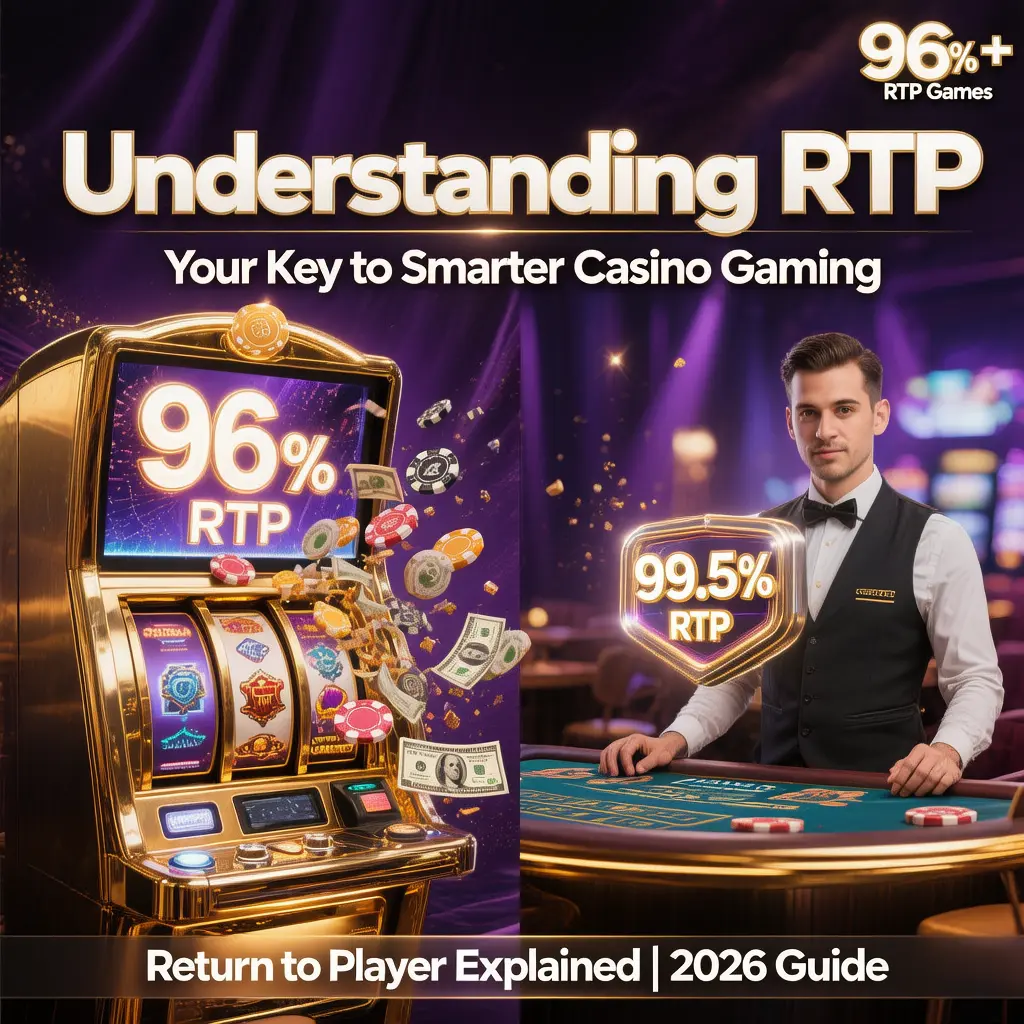Ever found yourself staring at two online slots, wondering which one to play? One has flashy graphics, the other a simpler design. But what if the real difference, the one that could affect your wallet, is hidden in a three-letter acronym: RTP? This guide will explain what is RTP in casino games in simple terms. The return to player explained here is a crucial piece of information for any player.
Within the first few paragraphs, you’ll grasp the meaning of this theoretical return and understand what does RTP mean in online slots. We’ll explore how this percentage impacts your bankroll, how to find high RTP games, and bust some common myths. Get ready to become a smarter player.

RTP is a key metric for understanding potential returns from slot games.
Understanding RTP: The Basics Explained
What Does RTP Mean in Online Casinos?
So, what does RTP stand for? RTP means Return to Player. It’s a percentage that tells you how much of the total money wagered on a casino game is expected to be paid back to players over a long period. Think of it as the game’s generosity score. The RTP percentage is a core concept in understanding the casino payout rate.
For example, if a slot has a 96% RTP, it means that for every £100 bet on the game, it will theoretically return £96 to players. The key words here are “theoretically” and “over a long period.” This theoretical return isn’t calculated over a few dozen spins but over millions, even billions, of game rounds. This statistical expectation ensures fairness and is verified by independent testing agencies. While most associated with slots, RTP applies to all casino games, from roulette to blackjack.
A 96% RTP means the casino has a 4% advantage over the long run.
How is RTP Calculated in Online Casinos?
The calculation for RTP is straightforward in theory but complex in practice. The basic formula is:
RTP = (Total Amount Won by Players / Total Amount Wagered by Players) × 100
Game developers don’t just guess this number. They use powerful computers to run millions of simulated spins to verify the game mathematics and ensure the outcomes align with the intended RTP. This process considers every possible winning combination, the probability of outcomes, and their corresponding payouts.
Let’s look at a simple example. Imagine a game over one million spins:
- Total Wagered: £1,000,000
- Total Won by Players: £970,000
- RTP Calculation: (£970,000 / £1,000,000) × 100 = 97%
Because this calculation requires a massive sample size of data, it’s impossible for an individual player to calculate it accurately during their own gameplay. You must rely on the figures published by the game developer and the casino.
RTP vs House Edge: Two Sides of the Same Coin
If RTP is what the game gives back, the house edge is what the casino keeps. They are two sides of the same coin and always add up to 100%. The relationship between RTP vs house edge is simple:
House Edge = 100% – RTP
A higher RTP always means a lower house edge, which translates to better odds for the player. This casino advantage is how casinos make a profit and stay in business. For players, seeking a lower house edge is a smart strategy to maximize potential returns. The expected value of your bets is higher on games with a lower house edge.
| Game | Average RTP | House Edge |
|---|---|---|
| Blackjack (with optimal strategy) | 99.5% | 0.5% |
| European Roulette | 97.3% | 2.7% |
| Baccarat (Banker Bet) | 98.94% | 1.06% |
| Most Online Slots | 96% | 4% |
| American Roulette | 94.74% | 5.26% |
RTP and House Edge are inverse concepts; as one goes up, the other goes down.
How RTP Affects Your Chances of Winning
RTP vs Actual Payout Over Time
Here’s a crucial point: the RTP percentage is a long-term average, not a promise for a single session. The difference between theoretical RTP vs real money returns can be huge in the short term. This is due to something called variance or volatility.
Your RTP vs actual payout over time will fluctuate wildly. Let’s imagine playing a 96% RTP slot:
- After 100 spins: You might be up 150% or down 80%. Your actual RTP for this session could be anything. This is due to short-term variance.
- After 10,000 spins: Your results will likely be closer to the 96% mark, but significant deviations are still common.
- After 1,000,000+ spins: Your actual payout will converge very closely to the theoretical 96% RTP. The large sample size smooths out the variance.
For casual players, this means you shouldn’t expect your session results to match the advertised RTP. You could win big or lose your budget quickly, and both outcomes are normal.
Does Bet Size Affect RTP?
A common question is whether changing your bet size can improve winning odds. In almost all cases, the answer is no. The RTP percentage is fixed and does not change whether you bet £0.10 or £100 per spin. The game’s core math remains the same.
What does change is the potential size of your wins or losses in absolute terms. A larger bet on a winning spin yields a larger cash prize, but a losing spin depletes your bankroll faster. Your betting strategy should focus on managing your bankroll impact, not trying to alter the game’s RTP. While extremely rare, some older games or specific “ante bet” features might offer slightly different RTPs at different stake levels, but this will always be specified in the game’s rules.
RTP Across Different Casino Games
RTP for Blackjack vs Slots Comparison
Not all games are created equal when it comes to casino RTP rates. There’s a significant difference in the RTP for blackjack vs slots comparison. Table games that involve skill generally offer higher RTPs than games of pure chance like slots.
- Blackjack: Can reach over 99.5% RTP, but this requires playing with a perfect “basic strategy.” Deviating from this strategy will lower your effective RTP.
- Slots: Typically range from 92% to 98%. The average is around 96%.
- Roulette: European Roulette offers a 97.3% RTP, while the American version with its extra “00” pocket drops to 94.74%.
- Baccarat: Offers a high RTP of around 98.94% on the Banker bet.
The reason for this difference is the element of skill. In blackjack, your decisions directly influence the outcome, whereas in slots, the result of each spin is determined entirely by a Random Number Generator (RNG).
Do Live Casino Games Have RTP?
Yes, absolutely. The question “do live casino games have RTP?” is common, and the answer is that they function on the same mathematical principles as their digital counterparts. The RTP for a live casino game is determined by the rules of the game itself, not by the actions of the human dealer.
For example, Live Blackjack has an RTP of around 99.5% if you play with optimal strategy, just like the RNG version. Live Roulette’s RTP is 97.3% for the European wheel. The dealer is there to facilitate the game, but the odds are baked into the rules and the equipment (the deck of cards, the roulette wheel). Sometimes, live games may have a slightly lower RTP to cover the higher operational costs of running a live studio, but they are still highly competitive.
Highest RTP Games by Category
If you want to find high RTP games, knowing where to look is key. Here is a list of some of the best high RTP casino games 2025, broken down by category. These games are known for giving players excellent long-term value.
| Category | Game Name | Provider | RTP (%) |
|---|---|---|---|
| High RTP Slots | Book of 99 | Relax Gaming | 99.0% |
| Mega Joker | NetEnt | Up to 99.0% | |
| 1429 Uncharted Seas | Thunderkick | 98.6% | |
| Table Games | Blackjack (various) | Multiple | ~99.5% |
| European Roulette | Multiple | 97.3% | |
| Video Poker | Jacks or Better (full pay) | Multiple | 99.54% |
| Deuces Wild (full pay) | Multiple | 99.73% |

Choosing high RTP games can extend your playtime and improve long-term value.
RTP and Volatility: Understanding the Difference
What is Volatility vs RTP?
RTP and volatility are the two most important metrics of a slot game, but they measure different things. The volatility vs RTP relationship is key to your game selection strategy.
- RTP (Return to Player): Tells you how much a game pays back over the long term.
- Volatility (or Variance): Tells you how that money is paid out. It describes the frequency and size of the wins.
The difference between RTP and hit frequency is a good way to think about it. A low volatility slot has a high hit frequency, paying out lots of small wins often. A high volatility slot has a low hit frequency but can deliver massive wins infrequently. Two slots can have the exact same 96% RTP but offer completely different gameplay experiences due to their variance impact.
High RTP vs High Volatility: Which is Better?
There is no single “better” option; it all comes down to your personal preference, risk tolerance, and bankroll. Your game selection strategy should align with your goals.
- High RTP + Low Volatility: Ideal for players who want longer playing sessions, steady gameplay, and to make their bankroll last. You’ll get frequent, smaller wins.
- High RTP + High Volatility: Suited for thrill-seekers and players chasing huge jackpots. You’ll experience longer dry spells but have the potential for life-changing wins. This is often a good combination for clearing bonus wagering requirements.
To choose best RTP games, you must also consider volatility. A conservative player might prefer a 97% RTP low-volatility slot, while a high-roller might opt for a 96% RTP high-volatility game for that shot at a massive payout.
Finding and Verifying RTP Information
How to Find RTP Percentage on Slot Games
Reputable online casinos and game providers make it easy to check slot RTP. Here’s a step-by-step guide on how to find RTP percentage on slot games:
- In-Game Information: Almost every modern slot has an “i” (info) or “?” (help) button. Clicking this will open the game’s rules and paytable, where the RTP is usually listed.
- Casino Website: Many casinos list the RTP directly on the game’s thumbnail or on a dedicated game description page.
- Game Provider’s Website: The official websites of developers like NetEnt, Pragmatic Play, or Play’n GO often have detailed sheets for all their games, including the RTP.
- Third-Party Review Sites: Reputable iGaming news and review sites (like Anilgnews) compile and verify this information for players.
If you can’t find the RTP for a game easily, it can be a red flag. Transparency is a hallmark of a trustworthy casino.
The game’s information or help section is the first place to look for RTP details.
RTP Disclosure Requirements by Regulators
Player protection is paramount, and gambling regulators enforce strict rules about RTP. The RTP disclosure requirements by regulators vary by jurisdiction, but the goal is always transparency.
- UK Gambling Commission (UKGC): One of the strictest regulators. As per their rules, operators must display the RTP. Notably, a rule change was announced requiring a minimum RTP on some game types, reflecting a push for fairness.
- Malta Gaming Authority (MGA): Another top-tier regulator that mandates a minimum RTP, which is generally 85% for individual games, though most games offered are much higher.
- Other Jurisdictions: Licensing bodies in Gibraltar, Curacao, and various US states also have their own regulatory requirements concerning RTP transparency and fairness.
Playing at casinos licensed by these authorities ensures that the games are fair and the stated RTP is accurate, as they are subject to regular audits.
Can Casinos Change RTP on Slot Machines?
This is a major concern for players: can casinos change RTP on slot machines? For online casinos, the answer is generally no. The RTP is set by the game provider who develops the slot. The casino simply licenses the game and cannot alter its core mathematics.
However, there is a crucial exception: some providers offer multiple RTP versions of the same game (e.g., a 96%, 94%, and 92% version). The casino operator then chooses which version to offer its players. This is why it’s vital to check the RTP at the specific casino you’re playing at. Land-based casinos have more flexibility to change the RTP on physical machines, but this is a regulated process. Playing at licensed online casinos with certified games from reputable providers is your best protection against RTP manipulation.
RTP Verification and Certification
Independent RTP Testing and Audits
How do you know the advertised RTP is real? This is where independent testing agencies come in. Organizations like eCOGRA, iTech Labs, and Gaming Laboratories International (GLI) are the gold standard for fairness verification.
Their role is to conduct rigorous RTP audits. They analyze millions of game rounds to compare the theoretical RTP (what the game is designed to pay) with the actual RTP (what it has paid out in a live environment). This process ensures RNG fairness and confirms that the game is performing as expected. When you see a certification seal from one of these agencies on a casino’s website, it’s a strong sign of trustworthiness and that you are playing certified games.

Agencies like eCOGRA provide crucial RTP verification services for player protection.
Theoretical RTP vs Actual RTP
As mentioned, there’s a difference between the designed RTP and what you experience. Let’s clarify:
- Theoretical RTP: This is the designed, advertised percentage (e.g., 96%). It’s a mathematical prediction based on the game’s rules and paytable, calculated over an infinite number of spins.
- Actual RTP: This is the real-world performance of a game over a specific period (e.g., one month). It’s calculated from live operational data.
During an audit, the actual RTP is checked against the theoretical RTP. Due to natural variance, it won’t be an exact match. However, it must fall within a statistically acceptable range. This ongoing payout percentage verification ensures the game remains fair over its lifetime.
Common RTP Misconceptions Debunked
To truly understand RTP casino mechanics, we need to bust some common myths.
- Myth #1: A 96% RTP means I’ll get £96 back for every £100 I bet.
Reality: No. RTP is a long-term average over millions of spins, not a guarantee for your short session. - Myth #2: A slot is “due” for a win if it hasn’t paid out in a while.
Reality: False. Every spin is independent and random, thanks to the RNG. Past results have no impact on future outcomes. - Myth #3: Betting more money increases the RTP.
Reality: Almost always false. RTP is a fixed percentage regardless of your bet size. - Myth #4: High RTP guarantees I will win.
Reality: No. A high RTP means a lower house edge, giving you better odds, but the casino always has an advantage over time. - Myth #5: All slots with the same RTP play the same.
Reality: Volatility makes a huge difference. A high-volatility 96% RTP slot will feel completely different from a low-volatility one.
Practical Strategies for Using RTP
Why RTP Matters for Casino Players
So, why RTP matters for casino players is simple: knowledge is power. Understanding RTP allows for informed decision-making and can significantly enhance your gaming experience.
- Smarter Game Selection: You can choose games that offer better long-term value.
- Better Bankroll Management: Higher RTP games can help your money last longer, giving you more entertainment for your budget.
- Meeting Bonus Requirements: Playing high RTP, low volatility slots is a popular strategy for clearing wagering requirements on casino bonuses.
- Setting Realistic Expectations: Knowing the RTP and volatility helps you understand that wins are not guaranteed and to play for fun.
Ultimately, using RTP helps you improve winning odds not by guaranteeing a win, but by choosing games where the mathematical odds are more in your favor.
Is 96% RTP Good for Online Slots?
The question “is 96% RTP good for online slots?” is one of the most frequently asked. The answer is: yes, 96% is considered the industry average and a solid benchmark.
Here’s a quick guide to the RTP percentage meaning in slots:
- Below 94%: Considered low. Often found in progressive jackpot slots where a portion of the RTP feeds the jackpot.
- 94% – 95.99%: About average. Perfectly fine to play, but better options exist.
- 96% – 96.99%: Good to very good. This is the sweet spot for many modern video slots.
- 97% and above: Excellent. These are considered high-RTP slots and are highly sought after by savvy players.
Best High RTP Casino Games 2025
Looking for the top-tier RTP casino games? Here is an updated list of the best high RTP casino games 2025 that you should keep an eye out for at licensed online casinos.
| Slot Name | Provider | RTP (%) | Key Feature |
|---|---|---|---|
| Book of 99 | Relax Gaming | 99.0 | Collect books to trigger free spins |
| Mega Joker | NetEnt | Up to 99.0 | Supermeter mode with higher payouts |
| 1429 Uncharted Seas | Thunderkick | 98.6 | Expanding wilds and beautiful design |
| Blood Suckers | NetEnt | 98.0 | Low volatility and a vampire-slaying bonus |
| Starmania | NextGen | 97.87 | Stacked wilds and frequent free spins |
| White Rabbit Megaways | Big Time Gaming | 97.77 | Feature Drop and extending reels |
| Rainbow Riches Pick n Mix | Barcrest | Up to 98.0 | Choose your own bonus features |
| Jack and the Beanstalk | NetEnt | 96.3 | Walking wilds with re-spins |
| Halloween Fortune | Playtech | 97.06 | Free games with multipliers |
| Big Bass Splash | Pragmatic Play | 96.71 | Popular fishing-themed bonus round |
Advanced RTP Considerations
How Bonus Features Affect RTP
The total RTP of a slot includes every part of the game, including the base game, free spins, and any bonus rounds. The feature contribution to the overall RTP can be significant. For some games, a large portion of the RTP is locked behind the bonus features. This means you might experience a lower RTP in the base game, with the potential for big returns during the free spins RTP or bonus rounds.
Some modern slots even offer a “Feature Buy” option. This allows you to pay a premium to trigger the bonus round instantly. Often, the RTP for playing with the feature buy is slightly higher than the base game’s RTP, but it’s a high-risk, high-reward strategy.
RTP Ranges and Multiple RTP Versions
As briefly mentioned, a growing trend is for providers to release games with an RTP range. This means the same slot title might be available in several multiple RTP versions, for example, at 96.5%, 94.5%, and 92.5%. The online casino operator chooses which version to offer.
This practice allows casinos to adjust to different markets and regulatory environments. For players, it means you can’t assume a game has the same RTP at every casino. It reinforces the importance of always checking the RTP in the game’s info file before you play.
Progressive Jackpots and RTP
Progressive jackpot slots like Mega Moolah often have a lower base RTP. This is because a small percentage of every bet is siphoned off to feed the massive, ever-growing jackpot pool. The jackpot impact on RTP is significant.
For example, a progressive slot might have a total RTP of 93%, but this could be broken down as:
- 88% Base Game RTP
- 5% Jackpot Contribution
You are essentially trading a lower return in regular play for a lottery-style shot at a life-changing win. Whether this trade-off is worth it depends entirely on your goals as a player.
Key Takeaways: Making RTP Work for You
You’ve learned a lot about RTP explained casinos. Here are the most important points to remember to make RTP a part of your game selection strategy.
- Always Check the RTP: Make it a habit to check the RTP before playing any new game.
- Higher is Generally Better: A higher RTP gives you better long-term odds and a lower house edge.
- Consider Volatility: RTP tells you “how much,” but volatility tells you “how.” Combine both for the full picture.
- Play at Licensed Casinos: Only play at regulated casinos to ensure the RTP is fair and verified.
- Set Realistic Expectations: RTP is a long-term average, not a short-term promise. Play for entertainment.
- Use RTP for Selection, Not Prediction: Use RTP to choose smarter games, not to predict when a win is “due.”
By keeping these points in mind, you can navigate the world of online casinos more confidently and get the most value out of your entertainment budget. Always remember to gamble responsibly.
With over 20 years of experience in the iGaming industry, Anilgnews provides expert analysis and in-depth content to help players and operators navigate the complexities of online gambling regulation. Contact Here For Paid Collaborations anilguptadm12@gmail.com.






One thought on “What is RTP in Online Casinos? How Return to Player Affects Your Winnings”